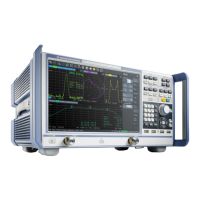Concepts and Features
R&S
®
ZNB/ZNBT
209User Manual 1173.9163.02 ─ 55
where r = S
21,reflected
/ S
21,direct
.
Measurement Procedure for ANSI C63.25
See the Rohde & Schwarz Application Card "Fast validation of EMC Test Sites above 1
GHz with Time-domain S
VSWR
", published on the Rohde & Schwarz internet site.
TD S
VSWR
measurement in accordance with ANSI C63.25 require a R&S ZNB20,
R&S ZNB40 or R&S ZNBT20.
5.7.2.7 Extended Time Domain Analysis
Option R&S ZNB-K20 / R&S ZNBT-K20
Option K20 extends the basic Time Domain representation capabilities of option K2 by
signal integrity testing functionality in the time domain.
Simulated Eye Diagram
With the impulse response calculated from the measured S parameters using the
inverse Fourier transform, it is possible to predict the system response to arbitrary time
domain signals by calculating the convolution of the input signal with the impulse
response.
With option R&S ZNB/ZNBT-K20, the R&S ZNB/ZNBT firmware implements a "virtual"
signal generator that is able to generate multilevel PAM signals (NRZ, PAM-4, PAM-8,
PAM-16), including a simulated low pass behavior. The simulated eye diagram using
the DUT's measured S parameters gives an extensive overview regarding the signal
integrity of the system.
Further building blocks for pre-emphasis, jitter, noise and equalization allow you to syn-
thesize effects of transmitter and receiver parts in the transmission system.
Optional Extensions and Accessories

